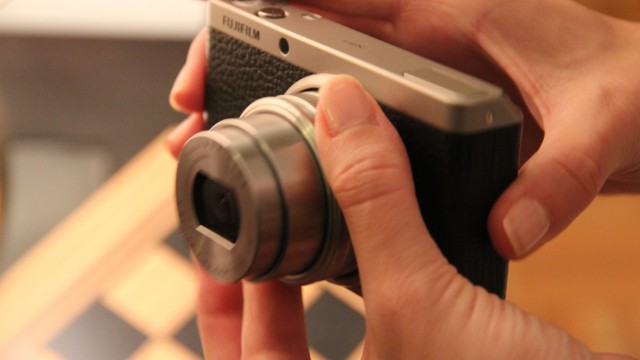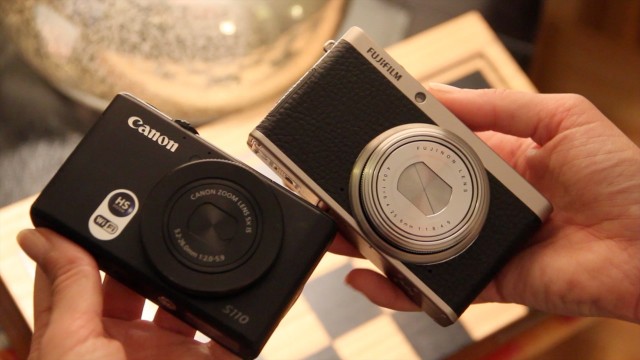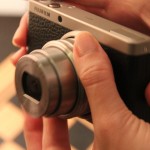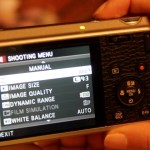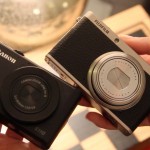We all know a few camera snobs. Maybe you’re one of them — and prefer to call yourself a camera “enthusiast.” For these people, simple point-and-shoots or smartphone cameras just don’t do the trick.
With this customer in mind, Fujifilm has introduced the XF1, a $499 digital camera that’s more compact than a big-bodied DSLR with interchangeable lenses, but has some of the manual controls and capabilities of its higher-end cousins. Its funky retro design will catch the eyes of vintage camera lovers.
Most notably, the camera has a manual control 4x optical zoom that also acts as its power function. Twist the lens a bit, and the camera is in standby mode. Fully extend the lens, and the camera turns on and is ready to shoot. To power off, you rotate and press the lens back into the camera body.
This hands-on, manual zoom may feel more familiar for consumers who have experience with DSLRs. During testing, it allowed for more precision when I was taking pictures, and the lack of electronic zoom means the camera can get more than 300 shots per battery charge. I’ve been using the XF1 for over a week now, and I’m pretty pleased with it.
But beyond its bells and whistles, the XF1 lacks a couple of features that are becoming standard in digital cameras.
With its blend of auto and manual settings and its $499 price point, the XF1 joins the ranks of cameras like Canon’s $449 PowerShot S110 (an updated version of the popular PowerShot S100) and the Sony RX100, which retails for a whopping $649. But the XF1 lacks a touchscreen display and Wi-Fi capabilities, two features of the Canon S110. The XF1 doesn’t have built-in GPS, either.
And while it’s smaller than top-of-the-line DSLRs, the XF1 is still just a bit bigger than some of its compact competitors. The zoom/power function requires two hands to shoot, whereas the Canon and Sony are small enough to use with one hand.
The XF1 measures 4.2 inches by 2.4 by 1.2 inches, and weighs just under half a pound. It has a solid aluminum body with a dimpled synthetic leather covering that comes in red, black or tan. It has a three-inch LCD display.
On the top edge of the camera, you’ll find the shooting button, the setting wheel and a little pop-up flash. On the back, there are two more command dials, a playback button and “E-fn,” a customizable shortcut button.
I was able to customize the E-fn button so that white balance and ISO control, as well as raw image capture, were just a couple taps away.
The camera has a 12 megapixel, 2/3-inch image sensor that allows for better image quality than photos captured with a basic point-and-shoot. For more advanced users, there are a multitude of settings that allow for manual fine-tuning.
But the XF1 can make less-skilled photogs look good, too: Even in auto mode, the camera captured sharp, professional-looking images with just the right amount of blur in areas outside of the focal point.
The Fujifilm XF1 also has an EXR mode, basically a high-powered auto mode. I found myself shooting in this mode the most.
With EXR, the camera looks for faces to focus on and continually adjusts the focus. It also employs scene recognition. So, on a bright sunny day, the camera would automatically go to a high-resolution mode, while in low light it would reduce the overall resolution of the image to prevent it from looking too noisy.
The downside of EXR mode is that it can drain the camera’s battery more quickly. Also, when I was taking pictures of moving subjects — whether taxicabs on the street or falling snowflakes — both auto and EXR were apt to capture blurry images, so a manual setting that allows for shutter speed adjustment is best for these scenarios.
These days, a digital camera would not be complete without plenty of filters to slap on your pics. The XF1, like the Canon S110 and Sony RX100, has a variety of filters that can be previewed in the display screen.
These are buried in Advanced mode, and include a “toy camera” effect with darkened edges, a “color pop” mode, and a handful of partial color settings that create monochrome images with a single color standing out. I spent a day playing hipster, taking pictures of the Brooklyn Bridge with various filters, and I have to say I really liked the results.
The XF1 records video in full 1080p HD. My video clips looked crisp, and the camera captured good sound — although, it doesn’t have an input for an external microphone. The red designated video button on the back is pretty handy, and the wheel on top of the camera doesn’t have to be turned to any kind of “TV” mode first, so you can just point and record.
The XF1’s complexity at times veered toward confusing. The camera can show as many as 31 different indicators on the display, meant to be helpful hints or warnings, and I couldn’t seem to shake one blur warning.
Fujifilm suggested it was because I was shooting in low-light areas, but this happened even in decent light. (And one of the claims with this camera is that it’s supposed to be excellent in low light.)
Another example? For video clips there’s a “YouTube” option, which apparently does nothing except mark your clips, since the camera isn’t equipped with Wi-Fi.
And, because I had to refer to the instruction manual quite a bit, I also found a couple instances in which the manual was misleading.
Overall, the XF1 is a solid camera for photo hobbyists and “prosumers” looking for a little style and a lot of control. Those who aren’t sold on the manual zoom might want to try other midrange cameras, such as the Canon S110, before committing to the $499 Fujifilm XF1.



